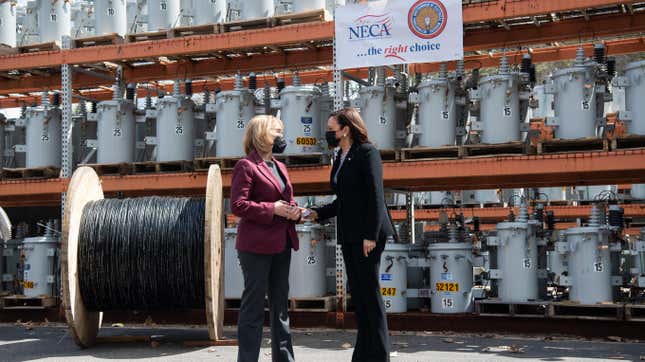
Internet data usage is skyrocketing these days, to no surprise.
In 2020, the average amount of internet data usage for an individual household was 483GB per month. By the end of this year, the average broadband consumption per household per month could hit 600-650GB, according to Mark Trudeau, CEO of OpenVault, a broadband data and analytics solutions company. It makes sense that broadband consumption increased drastically during the pandemic since millions of people were working or attending school from home.
But there’s a huge problem. If the U.S. is to keep pace with domestic broadband demand and also remain competitive with other countries that have more robust internet infrastructure, it needs to stop giving subsidies to the big internet service providers and invest in government-run and local networks instead.
The Biden administration has a grand plan to pour $100 billion into closing the digital divide. The plan promises to bring every American, specifically the more than 35% of rural Americans who lack high-speed internet, affordable, reliable, fast broadband. According to Axios, the plan would prioritize spending for government-run or nonprofit networks like municipal broadband or electric co-ops.
Unlike major ISPs such as AT&T, Comcast, and Charter, these smaller, local providers are not beholden to shareholders with their sights on short-term investments—a big reason why the big companies have not done more over the years to replace old DSL lines with cable or fiber lines, or provide more last-mile service. (You shouldn’t have to take out a $10,000 newspaper ad just to get AT&T to connect that last-mile service to your house.)
Investors get their money back in a shorter amount of time if ISPs focus on only improving and upgrading internet infrastructure in densely populated areas. This also helps major ISPs keep a tight, monopoly grip over those areas, forcing customers to use their service. It doesn’t help that 22 states roadblock or completely outlaw municipal broadband, which not only would create broadband competition but would also lower the cost of monthly internet plans.
President Biden’s plan would also look for other ways to bring down the cost of internet services instead of continuing to give ISPs subsidies so they charge consumers less. The existing Connect America Fund (CAF), for instance, is not funded by the ISPs but by regular ol’ taxpayers—the fund shows up as a fee on phone and internet bills. And according to the Technology Policy Institute, universal service subsidies like the CAF have little to no effect on expanding broadband coverage in rural areas.
“We should take this opportunity to expect better results from universal service and continue the FCC’s newer and better ways of promoting coverage where it does not exist so that subsidies truly benefit consumers and not just rural ISPs,” wrote the TPI.
Many lawmakers and major ISPs like the current status quo for obvious reasons. They get subsidies and can continue getting free monies from the FCC through programs like the RDOF, even though some majors telecoms have been unable to meet agreed-upon deadlines for broadband rollout, and they get to lock out competition.
Unsurprisingly, Republican lawmakers and lobbyists are strongly opposed to Biden’s plan. Michael Powell, CEO of the Internet and Television Association (NCTA) and a former Republican chairman of the Federal Communications Commission from 1997 to 2005, recently told Axios he believed “the idea that the private sector and profit incentives are intrinsically unsuited to do the job is ‘surprisingly Soviet,’” and that the faith many had in the government to build and run nationwide broadband networks was “unfounded.” It seems like an ironic position to take considering some of the NCTA’s core values include closing the digital divide and maintaining an open internet. But then again, the NCTA did receive donations from various persons affiliated with major privately-owned ISPs in 2020.
Creating government-run broadband, or even just investing in nationwide last-mile fiber infrastructure, will “create jobs in both urban and rural areas and provide a clear, tangible benefit to millions of Americans,” according to the Council on Foreign Relations. Not only does the CFR support Biden’s internet plan, but the organization also believes the internet should be considered a utility.
“Like electricity, water, and sewer services, high-speed, fiber-based internet access lines should be considered a utility that needs to be connected to every home. Once constructed, this network should operate under an open access policy, overseen and enforced by the government, that allows any ISP to access the infrastructure at reasonable, nondiscriminatory prices to offer its services,” said the CFR.
A recent study from Reviews.com showed 40.2% of consumers would consider immediately switching to municipal broadband if it was available in their location. Another 10.9% of consumers said they would definitely make the switch, while 29.3% said they would at least try it out. It’s clear people want and need more affordable and more equitable access to the internet. While early adopters of SpaceX’s Starlink are having great experiences with the fledging satellite internet service, Starlink is probably best suited for rural Americans, not urban dwellers. We need a comprehensive, nationwide approach like the one outlined in Biden’s plan to ensure the U.S. closes the digital divide and keeps pace with other countries.